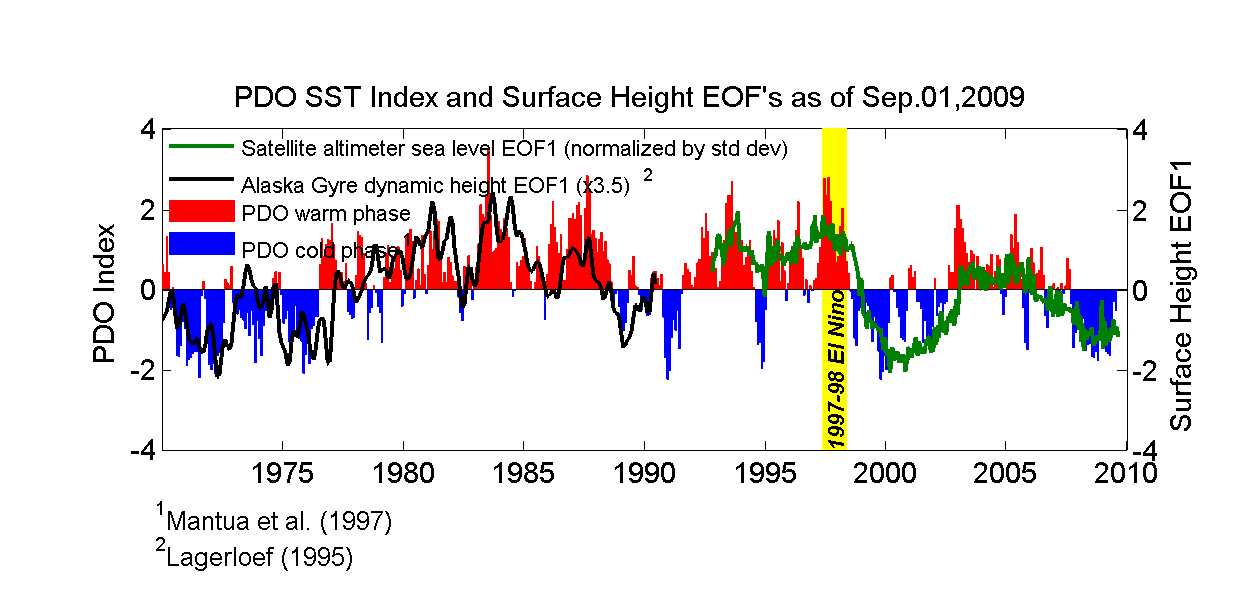Pacific Decadal Oscillation (PDO)
The Pacific Decadal Oscillation is a long-term fluctuation of the Pacific Ocean that waxes and wanes between cool and warm phases approximately every 5 to 20 years. In the cool phase, higher than normal sea-surface heights caused by warm water from a horseshoe pattern that connects the north, west and southern Pacific, with cool water in the middle. During most of the 1980s and 1990s, the Pacific was locked in the oscillation’s warm phase, during which these warm and cool regions are reversed.
The “Pacific Decadal Oscillation” (PDO) is a long-lived El Niño-like pattern of Pacific climate variability. While the two climate oscillations have similar spatial climate fingerprints, they have very different behavior in time. Fisheries scientist Steven Hare coined the term “Pacific Decadal Oscillation” (PDO) in 1996 while researching connections between Alaska salmon production cycles and Pacific climate (his dissertation topic with advisor Robert Francis). Two main characteristics distinguish PDO from El Niño/Southern Oscillation (ENSO): first, 20th century PDO “events” persisted for 20-to-30 years, while typical ENSO events persisted for 6 to 18 months; second, the climatic fingerprints of the PDO are most visible in the North Pacific/North American sector, while secondary signatures exist in the tropics – the opposite is true for ENSO. Several independent studies find evidence for just two full PDO cycles in the past century: “cool” PDO regimes prevailed from 1890-1924 and again from 1947-1976, while “warm” PDO regimes dominated from 1925-1946 and from 1977 through (at least) the mid-1990’s. Shoshiro Minobe has shown that 20th century PDO fluctuations were most energetic in two general periodicities, one from 15-to-25 years, and the other from 50-to-70 years.
Major changes in northeast Pacific marine ecosystems have been correlated with phase changes in the PDO; warm eras have seen enhanced coastal ocean biological productivity in Alaska and inhibited productivity off the west coast of the contiguous United States, while cold PDO eras have seen the opposite north-south pattern of marine ecosystem productivity.

Causes for the PDO are not currently known. Likewise, the potential predictability for this climate oscillation are not known. Some climate simulation models produce PDO-like oscillations, although often for different reasons. The mechanisms giving rise to PDO will determine whether skillful decades-long PDO climate predictions are possible. For example, if PDO arises from air-sea interactions that require 10 year ocean adjustment times, then aspects of the phenomenon will (in theory) be predictable at lead times of up to 10 years. Even in the absence of a theoretical understanding, PDO climate information improves season-to-season and year-to-year climate forecasts for North America because of its strong tendency for multi-season and multi-year persistence. From a societal impacts perspective, recognition of PDO is important because it shows that “normal” climate conditions can vary over time periods comparable to the length of a human’s lifetime.
Source: https://jisao.washington.edu/pdo/
Current Conditions of PDO

Source: https://www.esr.org/pdo_index.html
Links
- About PDO https://www.esr.org/pdo_index.html
- https://earthobservatory.nasa.gov/IOTD/view.php?id=1541
- https://visibleearth.nasa.gov/view_rec.php?id=15763
- https://www.nwfsc.noaa.gov/research/divisions/fed/oeip/ca-pdo.cfm
- https://www.usgcrp.gov/usgcrp/images/ocp2006/pages/ocp06-fig9.htm
- https://www.jpl.nasa.gov/news/news.cfm?release=2008-066
- https://www.pmel.noaa.gov/foci/info/foci_tour/slide4.html
- https://earthobservatory.nasa.gov/IOTD/view.php?id=8703
- https://www.aoml.noaa.gov/phod/d2m_shift/index.php
- https://www.nasa.gov/topics/earth/features/20081209.html

